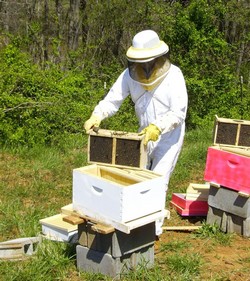Solving problems every tea drinker faces.
Exclusive subscriber benefits:
Receive four FREE quality ebooks worth $60
-
Save at least $5 during your first purchase
To produce a pound of honey, 556 worker bees have to fly 35,584 miles to and fro, which amounts to over three times round the world!
Bees are the only insects to produce food for humans. The food the honey bee produces is unique, good tasting, beneficial and nutritious.
So, how does a bee make honey?
Nectar Collection
Honeybees use nectar from flowers to make their honey. Nectar is the dusty like substance found on the flowers stamens. They use their long tube like tongues to suck the nectar out of the flowers and store it in their special honey stomach. Because they also have a regular stomach to hold their food, this stomach is only for holding the nectar, and when it is full, it weighs as much as the bee does!
And to fill this special stomach, the bee will visit between 100 and 1500 flowers. Each of these trips can cover 2 miles or more. In the peak summer months a worker bee literally works herself to death visiting flowers and transporting the precious cargo back to the hive.
During this frenzied time of activity in preparation for the coming winter, a worker bee only lives approximately 35 days. At the end of her days, her wings become so frayed that her usefulness is over and she is rejected by the colony. The work is continued by the ongoing supply of new workers.

Honey Processing
Once they’ve collected enough nectar, next job in the chain of events to make honey the worker bee has to process the nectar – they move the nectar into their mouth, and then they chew it for 30 minutes breaking down the complex sugars into simple sugars which make it easier for the bees to digest.
Once the worker arrives back to the hive, she passes the chewed mixture onto other worker bees that suck the nectar out through their mouths. Then the bees spread this chewed up nectar throughout the honeycombs cells that the bees have made inside the hive.
These honeycomb cells are all built of wax in a very specific hexagonal (six sided) design. Now the water begins to evaporate from the chewed nectar mixture. This makes the substance a lot thicker and the bees help this process of drying the nectar by fanning their wings on it.
The honey bees will continue this wing fanning, finally, leaving only about 18 percent water in the mixture. This is when it becomes honey, and once it is gooey enough, the bees put a wax cap over the honeycomb cell.
The effect of this capping is to make the honey a very stable food. Honey naturally resists molds, fungi and other bacteria, allowing it to last for years without refrigeration!
Food Pollination
In addition to gathering nectar to produce honey, honey bees perform a vital second function - pollination. About one-third of the human diet is derived from insect-pollinated plants, and honey bees are responsible for 80 percent of this pollination.
Pollination is the fertilization of a flowering plant. Honey bees are responsible for pollinating a variety of fruits, vegetables, legumes and more. Without honey bees our global food supply would be severely impacted.
So now you know how does a bee make honey, read History of Honey to uncover some ideas to help save the honey bees.
References
Photograph is kindly contributed by Dori and her husband Keith, who own and operate a farm located in the Western Foothill region of North Carolina, in the United States.
New! Comments: Like This Story? Leave A Comment!
Back to Top of How Does A Bee Make Honey?
Back to Raw Honey Main Page
Back to Amazing Green Tea Home
Solving problems every tea drinker faces.
Exclusive subscriber benefits:
Receive four FREE quality ebooks worth $60
Save at least $5 during your first purchase
Copyright� 2006-2024 Amazing-Green-Tea.com. All rights reserved.

